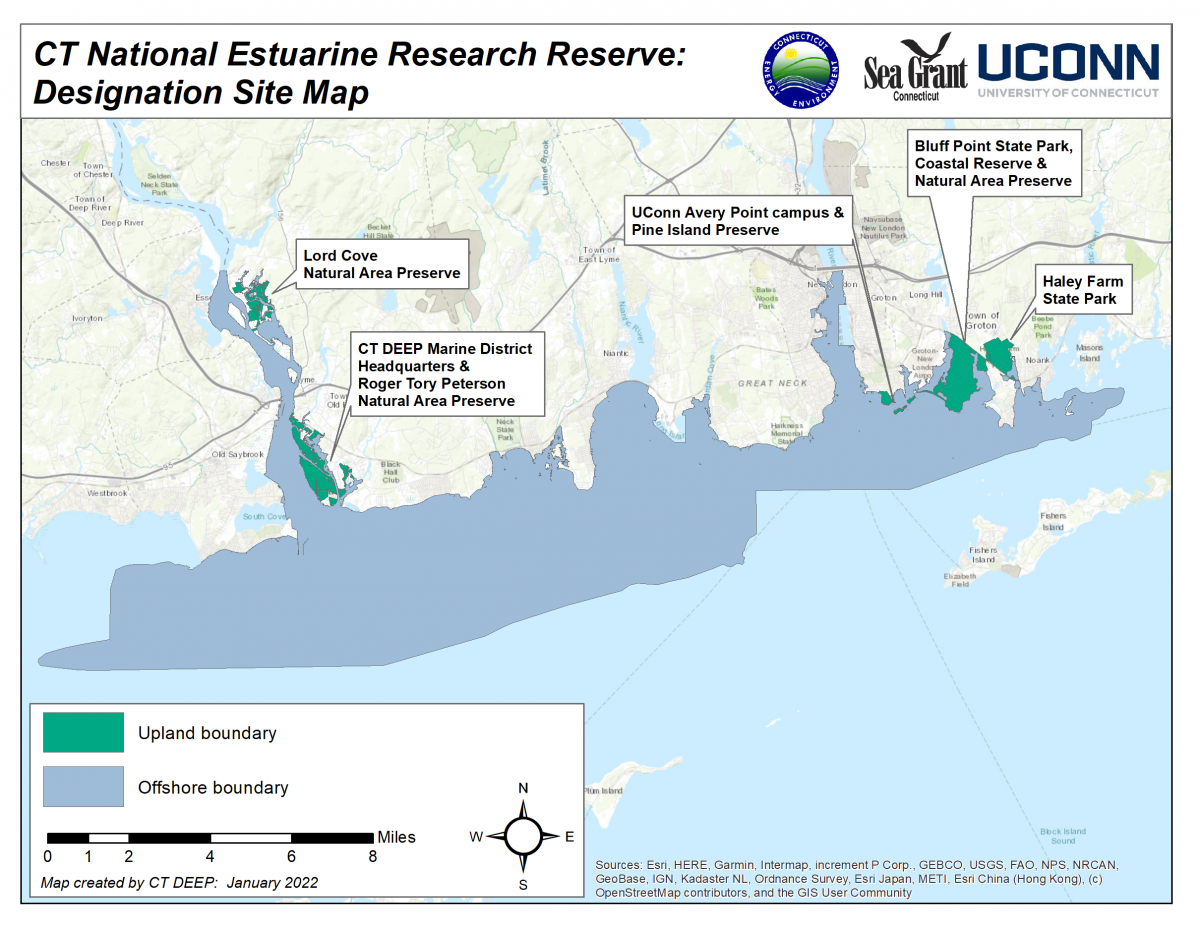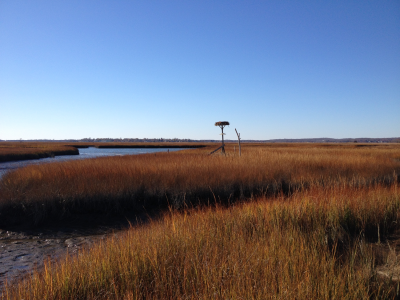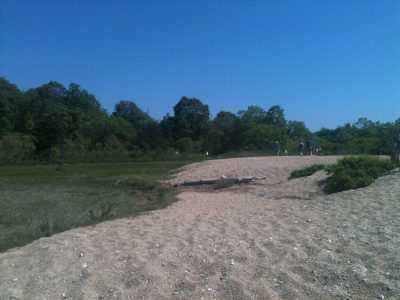Project partners including CT Sea Grant and congressional delegation members applaud designation of “living laboratory” that will protect habitat and provide expanded research, education and stewardship opportunities

The Connecticut Department of Energy and Environmental Protection (DEEP), the University of Connecticut (UConn), other partner organizations, and members of the state’s Congressional delegation applauded the National Oceanic & Atmospheric Administration (NOAA)’s announcement today that a network of state-owned properties in Lyme, Old Lyme and Groton, CT and portions of the surrounding waters has been designated as the nation’s 30th National Estuarine Research Reserve (NERR).
The NERR System is a network of coastal sites – including nearby locations in the Hudson River estuary in New York, Narraganset Bay in Rhode Island, and Waquoit Bay in Massachusetts – designated to protect and study estuarine systems. Established through the Coastal Zone Management Act, they represent a partnership program between NOAA and coastal states. NOAA provides funding and national guidance, and each reserve is led by a state organization with input from local partners. NERRs provide access to a variety of resources including municipal trainings on coastal best management practices, K-12 programs to engage students and teachers in hands-on science, expanded opportunities for estuarine research and long-term monitoring, and programs for environmental stewardship.

The Connecticut Department of Energy and Environmental Protection (DEEP) worked in close partnership with NOAA, the University of Connecticut (UConn), Connecticut Sea Grant (CTSG), the Connecticut Audubon Society (CAS), and numerous other organizations and individuals to lead the designation process. The resulting Connecticut NERR (CT NERR) includes the land areas of Lord Cove Natural Area Preserve, Roger Tory Peterson Natural Area Preserve (formerly Great Island Wildlife Management Area), Pine Island, Haley Farm State Park, and Bluff Point State Park, Coastal Reserve and Natural Area Preserve, as well as portions of the surrounding open-water areas of Long Island Sound and the Thames and Connecticut Rivers. It also includes the DEEP Marine District Headquarters in Old Lyme and the UConn Avery Point campus in Groton. These locations provide critical habitat for birds, fish, and other marine and coastal species of plants and animals in the region and the designation of these areas as a NERR will help provide valuable opportunities for these “living laboratories” to advance relevant efforts in environmental science, monitoring, education, and stewardship.
“The designation of the nation’s 30th National Estuarine Research Reserve in Connecticut represents a win for science-based decision making and helping to enhance environmental education at all levels for the people of Connecticut,” Governor Ned Lamont said. “We’re excited that some of the amazing natural resources of Long Island Sound, the Connecticut River, and some of our state parks and natural area preserves will be utilized as a ‘living laboratory’ that can help advance national efforts in addressing issues such as climate change and environmental stewardship now and in the future.”
“DEEP has been pursuing a Connecticut NERR for quite some time, and we’re thrilled to have reached this important milestone thanks to the efforts of a tremendous group of partner organizations,” DEEP Commissioner Katie Dykes said. “We look forward to working with our partners and NERR staff on important efforts and programming such as exploring efforts to sustain coastal habitats in the face of sea level rise and providing more opportunities for school-aged students to participate in real-world scientific field work. By doing so, these incredible estuarine places can be sustained and continue to support vital ecological and human uses.”
Members of Connecticut’s Congressional delegation applauded the news of the designation.
“This designation is a momentous scientific and environmental milestone for Connecticut,” U.S. Senator Richard Blumenthal (D-CT) said. “Connecticut’s National Estuarine Research Reserve will help provide essential scientific insights on coastal habitats, advancing our efforts to address climate change. It will also bolster hands-on environmental education programs for Connecticut schools, inspiring the next generation of scientists. I have long supported establishing this living laboratory and look forward to following its accomplishments in the years to come.”
“A vibrant Long Island Sound is vital to Connecticut’s economy and quality of life. This designation is a huge win for our state and will increase the funding Connecticut gets to improve the health of the Sound. I will continue to use my seat on the Appropriations Committee to grow support for the National Estuarine Research Reserve System so this new site can thrive,” said U.S. Senator Chris Murphy (D-CT).

Estuaries and their surrounding wetlands are found where rivers meet the sea. The resulting ‘brackish waters’ – which are saltier than rivers but not as salty as the ocean – support a thriving ecosystem that is home to a variety of unique plants and animals.
“Estuaries are complex systems that are home to organisms critical to a manifold of ecosystem services, fisheries, and human health,” remarked Dr. J. Evan Ward, Head of UConn’s Department of Marine Sciences. “The CT NERR will allow for increased study and understanding of estuarine systems to ensure their long-term sustainability.”
“The establishment of a research reserve on ecologically important sites on the Connecticut coast aligns with UConn’s commitment to sustainability and national reputation as a steward and champion of the environment, coastal resilience, and marine science,” said Radenka Maric, UConn Vice President for Research, Innovation and Entrepreneurship. “The estuarine reserve also presents our students and faculty with a protected environment for marine research and exploration.”
Designating a NERR is a lengthy process that typically takes years to complete. In Connecticut, it began in 2016 with an extensive effort to identify and assess possible locations. From those possibilities, one was submitted to NOAA as a nominee in 2019. After review and acceptance by NOAA, an Environmental Impact Statement (EIS) required by the National Environmental Policy Act (NEPA) was completed – along with a Management Plan to outline how the CT NERR will operate – in 2021. At all stages, input from stakeholders greatly helped ensure a successful outcome, and the effort has received support from state, local and private organizations and community leaders who recognize the benefits of additional local and national research regarding our estuarine environments and the variety of important uses they support. A Memorandum of Agreement signed by NOAA, DEEP and UConn became effective on January 14, 2022, completing the process.
“I am pleased that the designation process, led through an effective team approach, was inclusive and transparent, with input from stakeholders,” said Sylvain De Guise, Director of Connecticut Sea Grant. “It is important that the benefits of a NERR are clearly understood and supported by relevant local and state entities as well as neighbors.”
“The Connecticut Audubon Society is thrilled that the proposed National Estuarine Research Reserve has reached this important milestone,” said Patrick Comins, executive director of the Connecticut Audubon Society. “The process has been quite inclusive, with a wide variety of non-profit, governmental and educational institutions and the public participating in the process to ensure broad support of the nomination.”
Now that the CT NERR is officially designated, UConn will take on the role of the lead state agency responsible for the overall direction of the CT NERR programs and goals, with the Avery Point campus providing the primary administrative, research, and education offices. Since DEEP is the property owner and land manager of many the components, DEEP is recognized through a Memorandum of Agreement as a formal partner, continuing a long-standing tradition of environmental leadership from these two organizations.
“Connecticut has provided excellent partners for the designation process. We look forward to continuing this partnership as we begin to operate a research reserve for this state,” remarked Erica Seiden, NOAA manager of the National Estuarine Research Reserve System.
For more information, visit www.ct.gov/DEEP/NERR. Also, the current issue of CT Sea Grant’s biannual magazine Wrack Lines features six articles about the CT NERR. Click here to view the latest issue, or if you’d like a free print copy, send an email with your address to judy.benson@uconn.edu.
For more information on the National NERR System visit https://coast.noaa.gov/nerrs/.